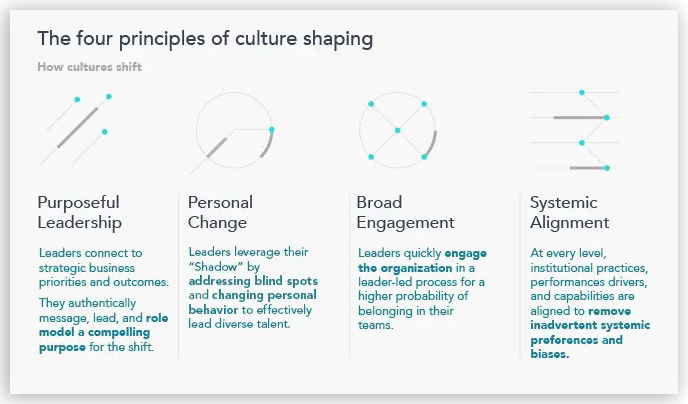
Executive Talent Magazine
For successful outcomes, a company’s shared beliefs and assumptions need to be foundational, intentional, and purpose driven.
In March, AESC member Heidrick & Struggles, a provider of global leadership advisory and on-demand talent solutions, announced its acquisition of businessfourzero, a London-headquartered consultancy specializing in developing and implementing purpose-driven change. Although the two companies are not new to each other, they are in the early stages of this business relationship It’s an opportunity for Heidrick & Struggles to shape culture based on its own four pillars — purposeful leadership, personal change, broad engagement, and systemic alignment (see illustration, directionTK).
The challenge for most organizations in merger and acquisition will be to “balance a 10-X opportunity against maintaining business stability by having a combined culture that is intentional, purpose-driven, and foundational,” as Heidrick & Struggles' partner Rose Gailey says. These qualities, Gailey says, are the key for any organization when it comes to culture and its being a successful driver of solutions for “the things that keep CEOs up at night — operating models, talent acquisition and retention, leadership, burnout.”
Culture forms foundation
During the Covid-19 pandemic, organizational culture was challenged, but it also was “the essential glue” that held organizations together, Gailey says. She likes to use the analogy of building a house. “You lay the foundation from a culture standpoint, and it needs to be strong. It needs to weather the elements to the degree that's possible. In that weathering, there [might be] damage done to the house, or at least a cause for remodel or repair. [Successful organizations] reconfigure the house’s structure, but the foundation continues to be strong. If it is weakened during the storm, you have to go back and reinforce and strengthen the foundation. You're not building a new foundation because you remodeled a room or replaced the windows. You come back and ensure that structure still fits.”
Culture’s real power comes to life when it is fully integrated at every point in a company’s purpose and strategy. “There’s an inextricable link for organizations between purpose, strategy, culture, and performance,” Gailey says. For companies looking at their operating model, at costs, at talent as a critical driver, the ultimate enabler is culture. It’s going to accelerate the delivery of value to shareholders and help them lean into mission and purpose. Culture answers the question, “’What is going to get us there?’,” Gailey says. It will define whether a company needs to “make behavioral shifts, intentional additions or deletions, or shifts even in their values.”
A recent Heidrick & Struggles survey of 500 global CEOs, “Aligning culture with the bottom line,” underscores the direct correlation leaders see between culture and financial performance. According to the report, in 2023, three times as many CEOs feel that culture is a key driver of financial performance versus just two years ago. To get there, they are focused on culture's impact on employee mindsets and behaviors as a critical driver of business outcomes, and they are overwhelmingly seeing positive results. Almost three quarters (71%) of CEOs highlighted culture as a top factor positively influencing financial performance—up from 26% in 2021 and more than half (59%) say it's either very important or crucial to link culture directly to strategy to see financial benefits.
Best intentions
When culture is foundational, everything else in an organization flows from it, so leaders must be intentional about shaping the culture. “Leaders can’t let the culture be shaped by circumstances,” Gailey says, particularly now when entire organizations need “to be agile enough to respond to the external factors that continually change in our world.”
Gailey admits the difficulty in pivoting but notes the consequences of not being intentional about culture and having it be part of any strategic adjustments a company might make. “People give up, and they move on, and that cripples an organization because they can't find talent. Or people stand up from an integrity and ethics perspective, and the organization has to address that. No industry can just stand still and succeed long-term. We all have to continually refresh, reframe, and reinforce the foundation.”
Authentic purpose
One reason Heidrick & Struggles acquired businessfourzero, Gailey says is because that company has “an incredible approach to alignment around purpose and understands the strong connection between an organization’s purpose and its strategy and culture.”
There are topics that are important at both the board and organizational level such as DEI (diversity, equity, and inclusion) and ESG (environmental, social and corporate governance). Gailey says many of their clients list culture work as part of their strategy for ESG “because they recognize the connectivity between authentically aligning employees’ focus on purpose-driven initiatives and reinforcing their culture.”
“There’s a phrase our chief diversity officer, Cecilia Nelson-Hurt, introduced to us,” Gailey says. “‘We need to eat our own cooking.’ We do that from how we think about culture for Heidrick & Struggles, in the work we're doing around inclusive leadership, and in the due diligence process with our recent acquisition. Culture is top of mind for both organizations even in the distinctions between us that will benefit our clients.”
If organizations want to see impacts, these strategies need to be based on “values they’ve committed to and that are cultural tenets,” Gailey says . “In this way [organizations] can define their competitive advantage through culture. And they need to believe in the behaviors that it will take to deliver on the strategy today and in the future.”
According to a Deloitte Insights report and 2019 Consumer Pulsing Survey in the U.S., U.K., China and Brazil, the three top issues consumers identified with while making brand decisions were how a company treats its employees (28% of respondents), treats the environment (29%), and supports the communities in which it operates (19%). In other words, consumers want to do business with companies that do good, that have a purpose-driven culture. Deloitte’s research also showed that “purpose-oriented companies report 30% higher levels of innovation and 40% higher levels of workforce retention than their competitors.”
All together now
This brings us back to Heidrick & Struggles and businessfourzero . “There’s a phrase our chief diversity officer, Cecilia Nelson-Hurt, introduced to us,” Gailey says. “‘We need to eat our own cooking.’ We do that from how we think about culture for Heidrick & Struggles, in the work we're doing around inclusive leadership, and in the due diligence process with our recent acquisition. Culture is top of mind for both organizations even in the distinctions between us that will benefit our clients.”
The companies are in a full integration process. “We’re working to build trust and get to know one another, to understand how we will come together and align our cultures. We are committed to understanding each other, not on an offering or a product level but on a how-we-work level,” Gailey says. “We’re coming at this with curiosity and excitement and possibility.”
She believes their successful pairing is about “creating a dependable drumbeat around purpose, strategy and culture and a cadence that's continually reinforced. It will give people a chance on a human level to be together. It’s literally eat together and spend time together, and then there are the operational elements that have to be put in place. Then from a strategy perspective, we’re thinking about how we will leverage this moment to accelerate beyond what we ever imagined.”
From her culture work, Gailey knows the hard realities for organizations going through a merger and acquisition and looking for synergies. “It isn't all rainbows and butterflies,” she says. But the important thing is “to maintain the balance of the why, the perspective, the understanding.” In other words, the purpose, the intention, and most of all the foundation that underpins everything.
